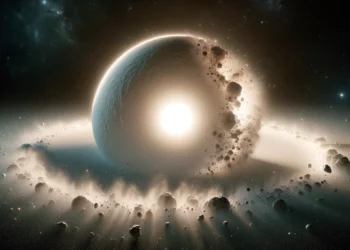
With all our shuttles and telescopes, we’ve still only just scratched the surface of the universe around us. Astronomers are constantly making new discoveries as we explore the vast cosmos and not a day goes by that we don’t learn something new about the cosmos we live in. Recently, researchers using the European Southern Observatory‘s (ESO) Very Large Telescope (VLT) made a groundbreaking discovery, finding fingerprints left by the explosion of the Universe’s first stars.
“For the first time ever, we were able to identify the chemical traces of the explosions of the first stars in very distant gas clouds,” says Andrea Saccardi, a PhD student at the Observatoire de Paris – PSL, who led this study during his master’s thesis at the University of Florence.
The first stars to form after the Big Bang, 13.5 billion years ago, were very different from the ones we see today. They contained only the simplest chemical elements in nature, hydrogen and helium. They were also tens or hundreds of times more massive than our Sun and relatively short-lived. These primordial stars quickly died in powerful supernovae, enriching the surrounding gas with heavier elements for the first time. Later generations of stars were born out of that enriched gas, and in turn, ejected heavier elements as they too died. But the very first stars are now long gone, making it challenging to learn more about them.
Cosmic elements
Using data from the VLT, researchers discovered three very distant gas clouds with a chemical fingerprint matching what we expect from the explosions of those first stars.
Depending on the stars’ mass and the energy of their explosions, these first supernovae released different chemical elements such as carbon, oxygen and magnesium, which are present in the outer layers of stars. But some of these explosions were not energetic enough to expel heavier elements like iron, found only in star cores.
To search for the telltale sign of these very first stars that exploded as low-energy supernovae, the team looked for distant gas clouds poor in iron but rich in the other elements.
This peculiar chemical composition has also been observed in many old Milky Way stars, which researchers consider second-generation stars that formed directly from the ‘ashes’ of the first ones. This new study has found such ashes in the early Universe, thus adding a missing piece to this puzzle. This discovery opens new avenues to indirectly study the nature of the first stars, fully complementing studies of stars in our galaxy.
To detect and study these distant gas clouds, the team used light beacons known as quasars — very bright sources powered by supermassive black holes at the centers of faraway galaxies. As the light from a quasar travels through the Universe, it passes through gas clouds where different chemical elements leave an imprint on the light. To find these chemical imprints, the researchers analyzed data on several quasars observed with the X-shooter instrument on the VLT. The X-shooter splits light into an extensive range of wavelengths, or colors, making it a unique instrument for identifying many different chemical elements in these distant clouds.
This study opens new windows for next-generation telescopes and instruments, like ESO’s upcoming Extremely Large Telescope (ELT) and its high-resolution ArmazoNes high Dispersion Echelle Spectrograph (ANDES). With ANDES at the ELT, astronomers can study many of these rare gas clouds in greater detail and finally uncover the mysterious nature of the earliest stars.






